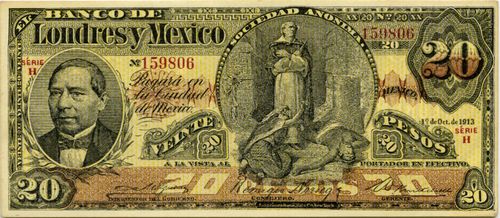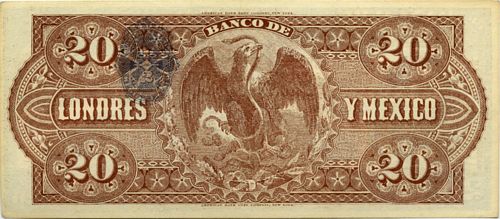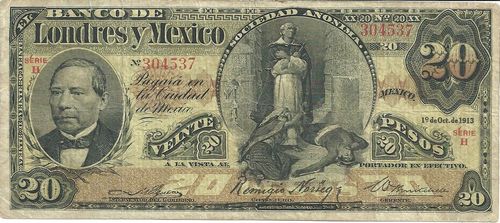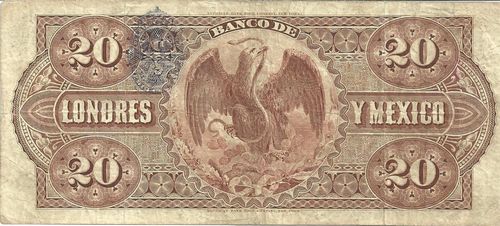Counterfeit $20 Banco de Londres y México notes


a counterfeit $20 note (H 159806)
It has long been noticed that there are two varieties of this $20 note. Carlos Gaytán believed that both were genuine, even though he thought that one was printed in Mexico by lithography on hard paper and not by the ABNC. Gaytán reasoned that at that stage of the revolution the bank could no longer afford the expense of having its notes printed in New York.
However, Gaytán was wrong.
Certainly, during the revolution, because of urgency, economy and speed of delivery, Mexican banks, including the Banco de Londres y México, did resort to locally produced issues from Bouligny & Schmidt and the American Book & Printing Company but these were new designs and a reputable bank would not have risked reproducing the American Bank Note Company’s imprint. The ABNC also managed, despite occasional difficulties and delays, to continue deliveries to Mexico throughout the revolution.
These notes were, in fact, good quality counterfeit produced in the United States. On 12 August 1916 Lacaud and Son, in San Antonio, Texas, wrote to the American Bank Note Company that counterfeit $20 notes had appeared and caused a certain amount of alarm along the borderABNC, folder 288, Banco de Londres y México (1916-1936). Because of their worries most of the exchanges that dealt in Mexican currency were refusing to accept Banco de Londres y México $20 notes. Lacaud and Son had been told that the falsification was so perfect that only an expert could distinguish it from the legitimate note and included a note (H 306812), which they thought was genuine but wanted the ABNC to review. In fact, the ABNC confirmed that this note was undoubtedly genuine, but replied that “if you could pick up what you consider is a counterfeit, we shall be pleased to have you get one of these notes and send it to us for our further examination: and if we ourselves can do something to help you in finding the counterfeiters, we shall be very glad to do so.”
On 24 August the Resident Agent in Mexico City, Charles Blackmore, wired a report that good quality counterfeit $20 notes were circulating in large quantities in San Antonio and the ABNC replied that they already knew and had placed the matter in the hands of the United States Secret Service, who were investigating. “As you readily understand this tremendously powerful service can do even more than can be done by us or anyone else.” Two days later Blackmore sent a specimen counterfeit (293697) and a copy of the notice that was being sent to the bank’s branches. Mr. Mitchell, the bank’s manager, had informed Blackmore that he was the first to notice the falsification in San Antonio, where he said a large quantity was being placed in circulation. Some one, a military man, had also brought a large packet of them to Mexico City. The bank's notice listed differences that had been noted by Mr. Murray, an intimate friend of Mr. Mitchell.
1) the paper used was approximately 60% linen whilst the genuine used 90% linen
2) the colour or tint in the genuine was an orange yellow (amarillo anaranjado) but darker in the counterfeit
3) the colour or tint behind the shading in the vignette was light in the genuine, but darker in the counterfeit so the figures were less embossed
4) the 20 in the bottom left hand side was more blurred in the counterfeit
5) the lettering in the promise to pay were entirely separate one from the otherBILLETES DE $20. del Banco de Londres y México.
El papel en que están impresos los billetes falsos del Banco de Londres y México contiene aproximadamente 60% de lino y los billetes buenos m. o. m. un 90% de lino.
El color o tinte de los billetes buenos es un amarillo anaranjado y el de los falsificados es más obscuro.
El tinte o color detrás de la sombra en las viñetas es claro y en los falsos el color es más obscuro y las figuras resultan con menos relieve.
El No. 20 en la extremidad izquierda inferior en los falso no aparece con la misma claridad que en los buenos.
La letra de la redacción de pago es enteramente distinta en unos y otros. (El Demócrata, Tomo III, Núm. 389, 2 September 1916).
On 25 August El PuebloEl Pueblo, 25 August 1916 reported that bogus $20 notes had appeared in Mexico City. It included an image of such a note (156623) and said that “at first sight the imitation is well accomplished; but on closer examination, it is noticeable that the inks on the reverse are a little weaker than on real banknotes. The printing details on some parts of the banknote are also a bit crude (un poco groseras)".
On 2 September Blackmore had an interview with Mitchell, who informed him that he had received an official letter from Aguilar, the Minister of Foreign Affairs, advising the bank that he had received a report from the Mexican Consul in San Antonio to the effect that the $20 notes of the Banco de Londres y Mexico had been falsified. In the same letter he stated that experts from the ABNC were in San Antonio, investigating. Mr. Mitchell has heard that banks in Laredo, Eagle Pass and El Rio in all good faith bought up quantities of the false notes.
E. R. Treadwell, the Assistant Manager of the Engraving Department, examined the note that Blackmore had sent and marked up the most easily detected differences, with these listed in an accompanying table, as followsABNC, folder 288, Banco de Londres y México (1916-1936):
| FACE | |||
| I. | Centre division line omitted. | VII. | Lines in sleeve omitted. |
| II. | Curve in letter different. | VIII. | Six lines of ruling here. Should be seven. |
| III. | Centre of letter different. | IX. | Treatment of eye radically different. |
| IV. | Top of letter not straight. | X. | No period after Co in original. |
| V. | Treatment of arm entirely different. | XI. | Body lines and hair lines joined; should not be. |
| VI. | Treatment of neck entirely different. | XII. | Different shaped “2”. |
| BACK | |||
| I. | Line is light in original. | IV. | Very different from original. |
| II. | Variation in lathe work. | V. | Treatment radically different. Color is lost. |
| III. | This part of pantograph not in original. |
I shall leave it to others, who possess actual notes rather than scans, to try to identity all the features that the ABNC recorded. Suffice it to say, that the two versions are easily distinguishable at first sight.
genuine

counterfeit
genuine

counterfeit
On 23 October Félix Martino, a director of the bank, who was passing through New York on a business trip, called on the ABNC and handed over some data that he hoped may be of use in tracing the counterfeiters. According to Martino, the factory or shop was established in San Antonio and the principal directors were said to be Kelly, Levi and two individuals by the name of Cicero, from the frontier states of Mexico. Apparently, on 12 September Kelly went to New Orleans carrying with him a large quantity of the notes with the purpose of placing them on the marketSD papers, 812.5158/56. If the factory or shop was not located in San Antonio, it was almost certain that it may be established in San Francisco, California, where the counterfeiting of the notes of the Constitutionalist Government has been carried on in a large scale.
The Secret Service tracked the counterfeiting to New Orleans, and the false plates were destroyed by the police with the intervention of the Mexican Consul at New Orleans
In December 1916 Ricardo Hickman Flores and Ricardo Hickman Mier were arrested in Torreón for passing counterfeit Banco de Londres y México notes, and had $1,300 on them when arrested. The Juez instructor militar sent some of the notes to the Juez quinto de Instrucción militar in Mexico City, and experts declared that the notes were false, even though they were perfect imitationsGladiador, Tomo I, Año I, núm. 23, 23 December 1916.
On 15 March 1917 El Pueblo reported that the Consejo de Incautación of the Banco de Londres y México had published the characteristics of the counterfeit twenty-peso bills recently discovered in MonterreyEl Pueblo, 15 March 1917.
The notes reappeared in 1922. On 30 March Ciro Melendez, of Torreón, asked whether a note ((H 293618, dated 1 October 1913) was genuine, as the bank had told him that the 25 or so such notes that he had were counterfeit. The ABNC confirmed that it was genuine. However, a month later, on 27 April, Isauro Martínez, of the Empresa Cinematográfica de Torreón, wrote that he had a number of notes that the bank had claimed were false. He sent the ABNC one (H 258851, dated 1 October 1913, marked "Falso") and requested “that you kindly examine it carefully and advise me if it is good or false as these notes have been in circulation in commerce for some years there being no difference between them and those which the said bank has always placed in circulation and moreover carrying your name as guaranty, which name is known in this country as a guaranty of the legality of bank notes". ABNC replied that Martínez’ note was counterfeit.
On 20 January 1931 Blackmore, the Resident Agent in Mexico City sent New York a clipping from that day’s issue of Excelsior reporting that a counterfeiting of notes had been discovered. However, the bank’s manager had told him that as so few of the bank’s notes ($2,000,000) were in the hands of the public, he considered the matter of little importance. He addded that the false notes were very similar to the genuine bank notes but did not bear the secret marks. The counterfeiting took place in New Orleans some years ago and the false plates were destroyed by the police with the intervention of the Mexican Consul at New Orleans. The bank’s manager thought that, probably, the police was unable to locate all the false plates and that some of them were sent to some place in the north part of Mexico but the ABNC’s view was that “it may be that an extra plate was not found and has again been used to print additional notes, it is just possible that the notes now appearing are old ones that have been hidden away and are now coming to light only because people feel, or think, they may be able to cash them.”
The Excelsior’s news item stated:
The banknotes of the Bank of London and Mexico have been counterfeited on a large scale, judging by a good number of them that have just been collected by the Federal Police, on the express orders of the Attorney General of the Republic, José Aguilar y Maya, who had reports that a subject who calls himself a commission agent, intended to exchange about five hundred pesos in the nearby capital of the State of Mexico, where he was apprehended red-handed. The defendant, who is already being held in the Mexico City prison, at the disposal of the First District Judge, to whom this scandalous fraud has just been referred, answers to the name of José Palemón García. When he was captured, he had in his possession 173 counterfeit notes from the Banco de Londres y México, of twenty pesos each, the origin of which he at first refused to explain. Subjected to a skilful interrogation, he finally confessed that: lacking work, he went some time ago to the city of Monterrey in search of new horizons and there he became friends with. Manuel Garza Méndez, a person well-known there, who, trying to favor him, gave him the aforementioned notes, to see if it was possible for him to sell them. He added that, having lost sight of his protector, he returned to this capital; but as he was still in a rather precarious situation, he set out for Toluca. Lacking funds even to meet his most pressing needs, he found himself in the need to sell or exchange $500 of the $3,460 that he kept in banknotes of the aforementioned Banco de Londres y México in his wallet. But it seems that, as the person to whom he proposed the transaction suspected the legitimacy of the notes, he spoke to the police and Palemón García was instantly arrested in the capital of the State of Mexico; he was later picked up by agents of the Federal Police, who brought him into the presence of. Aguilar y Maya, who ordered that other notes be looked for because there was news that the counterfeiting had been carried out on a larger scale. Palemón García had the rest of the counterfeit banknotes confiscated, since at first he stated that he was only had twenty-five of them; but later 148 were collected, which together with the above add up to the important sum that we make known. As soon as the detainee's full confession was obtained, an agent of the Federal Police left for Monterrey, managing to interview Garza Méndez, who stated that, in fact,when García asked for help, he gave him the 173 counterfeit notes that were collected; but warned him that they were not authentic, so as not to be involved Palemón García with the police, as has happened. Certain that the fraudulent issue of this paper of the Banco de Londres y México was not very small, the Attorney General of the Federation has ordered that new investigations continue to be carried out to find all the banknotes, which undoubtedly circulate in exchange houses and banking institutions, without prejudice to the fact that José Palemón García was consigned to the First District Judge as has already been done, to remove the notes and proceed to their incineration.”
Blackmore, still the ABNC agent, reported that the bank did not believe many counterfeits were in existence and that the Comité Liquidador de los Antiguos Bancos de Emisión, which was handling the liquidation of old banknotes, was aware of the secret marks that genuine notes carried and so would detect any forgeries.
Finally, it should be noted that a group of counterfeits appeared on the market in Mexico City in 1955. Known counterfeits seem to have serial numbers ranging from 156xxx to 161xxx, whilst the genuine notes were numbered 250xxx to 321xxx, though the counterfeit recorded in 1922 (258851) is a problem.


